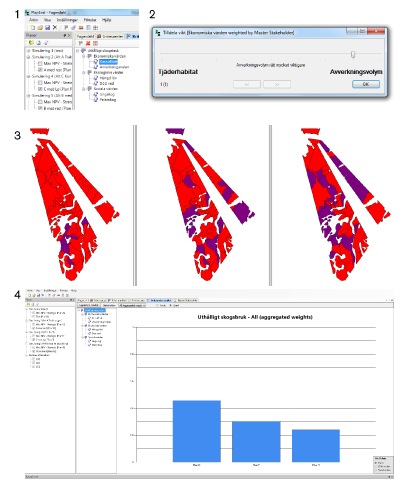PlanEval
PlanEval stands for Plan Evaluation and is intended to provide a systematical way to rank and evaluate plans and scenarios generated with PlanWise.
PlanEval can provide support in situations where a forest owner or other decision maker would like to analyze the impact of different scenarios from an economic, ecological or social angle. In such situations the first step is often the compilation of a sound knowledge base. This can be obtained by generating a number of forest scenarios, for example with PlanWise. For more complicated situations it is often not sufficient with just objective data e.g. the number of acres of a certain habitat that will be left if a certain management plan is implemented. Decision makers need to weigh up the effects of several factors e.g. the importance of grouse habitat area against the importance of a certain timber supply. Analysis with PlanEval can provide valuable support in such situations. PlanEval can even take into account different stakeholder's priorities and find a balance between them.
There are currently two different methods implemented in PlanEval for the evaluation of trade-offs between different objectives. The first of these is Analytic Hierarchy Process (AHP). AHP is a well-established method within the field of multi-criteria analysis and is based on making pair-wise comparisons of the objectives and alternatives. The method has been applied in many different areas and has been used in forest management for state owned land in Finland and for company owned land in Lycksele county council. The second method implemented in PlanEval is SMART. SMART is perceived by many as a simpler approach and is based on each stakeholder assigning points to the different targets. These points are then used to weigh up the different scenarios.
Assuming that the plans are generated with PlanWise then PlanEval works in four steps:
| 1. | The goals and objectives that the different plans will evaluate are defined |
| 2. | The decision maker evaluates the relative importance of each goal and objective |
| 3. | A result is calculated for each goal. |
| 4. | A ranking of the different plans is created that takes into account the decision makers evaluation of the relative importance for each plan |
Properly used, PlanEval can provide support in a decision making process taking into account multiple conflicting objectives, handle both qualitative and quantitative objective, provide structure to a problem and provide a model that can be used as a basis for planning discussions.


